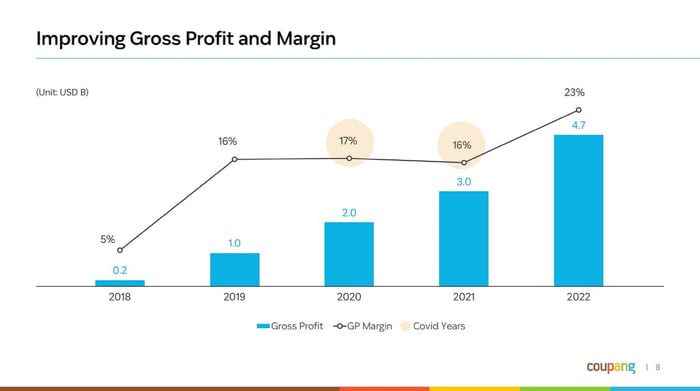Investors have never shown much love for the South Korean e-commerce marketplace Coupang (CPNG -2.28%). The company went public on March 11, 2021, at $63.50 per share, with a market cap of $102.2 billion, and since then, the stock has been on a long downhill slide. Today, the company trades almost 75% lower at less than $17, and the market cap has sunk to $28 billion.
As an unprofitable growth company, the stock responded poorly when the South Korean Central Bank started raising interest rates in August 2021. The country’s Central Bank’s 20-month campaign to choke off inflation resulted in the South Korean economic growth and private spending contracting 0.4% sequentially in the fourth quarter of 2022 — terrible for Coupang’s revenue growth.
While the South Korean economy looks gloomy over the first half of 2023, some analysts think it should begin to rebound from this slow growth period in the latter half of the year. So if you believe the South Korean economy will improve within the next 12 months, you should start buying Coupang’s stock today. Here’s why.
Why you should consider the company
According to Coupang CEO Bom Kim, 2022 was the year it would display its ability to rapidly grow its profitability while growing substantially faster than the South Korean retail market. The company lived up to the billing.
The company increased its 2022 gross margins by approximately 700 basis points (or seven percentage points) over the previous year to 23% — a substantial improvement. By improving gross margins, it gains greater flexibility to improve bottom-line profits while also investing back into the business to produce revenue growth.
Additionally, management spent the year focused on reducing operational costs and improving efficiencies to help create sustainable bottom-line profitability, which involved:
Improving its supply chainsAutomating processesScaling products and services that help improve operating marginsUpgrading technology and infrastructure
You can see on the chart below that management’s efforts have paid off, with 2022 operating expense growth sharply decelerating from 2021’s rapid rise and operating margins taking a significant jump higher.
CPNG Total Operating Expenses (TTM) data by YCharts. TTM = trailing 12 months.
Profitability is also rising. Coupang management likes to measure its bottom-line profitability using EBITDA (earnings before interest, taxes, depreciation, and amortization), which some analysts think is a better indicator of a company’s core profitability than net income. Its adjusted EBITDA margin in the fourth quarter of 2022 was 4%, substantially better than the negative 4.1% the company delivered in fiscal 2021.
Suppose management continues improving its margins; once the South Korean economy resumes growth and Coupang’s top-line revenue improves, it should result in substantial profits dropping to the bottom line and far more investor interest in this Korean e-commerce marketplace.
The best part is that Coupang didn’t chase profitability by sacrificing revenue growth and growing market share. According to CFO Gaurav Anand, “We continued to grow at a multiple of the market, with total dollar net revenue growth of 5% year over year, and constant-currency growth of 21% year over year and 6% quarter over quarter. Our revenue growth continues to be driven by the increase in our active customers and revenue per active customer.” In this context, constant currency means it grew its revenue by double-digits when calculated in its local currency of won instead of dollars.
Yet, despite the many indicators that it could be an excellent long-term profitable investment from current prices, you might ask, “If the company has so much growth and profitability potential, why has it never gained much love from investors?”
Why U.S. investors have hesitated to buy the company
As seen in the chart below, the market began valuing its stock increasingly less after observing quarter-after-quarter revenue deceleration.
CPNG PS Ratio data by YCharts. PS Ratio = price-to-sales ratio. YoY = year over year.
Adding insult to injury for the company, many U.S. investors’ unfamiliarity with South Korea has made them wary about investing in an early-stage company in a country they know little about. Many look at the country and see a land mass similar in size to the state of Oregon and view the market as limited and Coupang’s growth potential as meager.
In a post-pandemic era of e-commerce marketplaces that have fallen out of favor with investors, many people feel there are much better places to invest their limited funds.
Should you buy it?
While its land mass might be small, the World Bank ranked South Korea as the 10th-largest economy globally by gross domestic product in 2021. Also, unlike many investors’ perceptions, the company is far from pushing against any growth limitations. It has captured only 4.4% of its 2022 total addressable market estimated at $466 billion. So it has plenty of room to expand once economic growth in the South Korean market returns.
While fiscal 2022 revenue grew only 11.8% year over year, analysts who cover Coupang project fiscal 2023 revenue growth to rebound to 17%. Suppose you believe Coupang can meet or beat consensus analysts’ revenue projections for 2023; the market is valuing the stock far below its worth, and a wise investor might consider buying it today.
